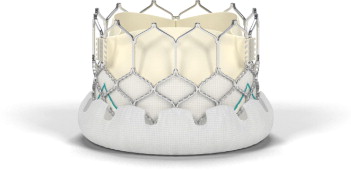Posted in Cardiovascular by Qmed Staff on November 19, 2013 The Sapien 3 could be used in a broader range of patients than earlier TAVR products introduced internationally.

Edwards Lifesciences (Irvine, CA) is in the news after The Heart Hospital Baylor Plano used the company's Sapien 3 heart valve for a transapical approach in a patient. The latest phase of this clinical trial, dubbed Partner II, could provide elderly patients who are poor candidates for surgery a second lease on life. The device could be used in a wider range of patients than the first two Sapien product generations and could enable greater accuracy in positioning.
Despite the advances in the Sapien platform (and other TAVR technologies such as Medtronic's CoreValve and Boston Scientific's Lotus), some question whether such valves are the best strategy for patients already too old or sick for conventional heart surgery. When transcatheter aortic valve replacement technology debuted, it was widely heralded as a game-changing technology. While many are optimistic of TAVR technology's potential, skepticism surrounding the technology is growing. As John Mandrola recently explained on Medscape:
Percutaneous valves: Really? I can't see it yet. Step back and look at this therapy with a wide-angle lens. Taking a frail elderly patient to the lab, inserting a huge stiff device through a tortuous femoral/iliac artery, then squishing the aortic valve and jimmying in a mechanical valve does not impress me as terribly innovative. The mitral-clip devices present a similar scenario: if a frail patient is too frail for heart surgery, how much difference will it make to marginally reduce the MR jet? I hate to sound unimaginative here, but what the elderly patient with valvular disease "needs" most from cardiologists are much bigger doses of Hoosier common sense. Someone needs to look away from the echo and look at the person considered for such furious treatment. We look foolish when we overtreat the elderly.
Still, future generations of the technology could help boost device performance, making it suitable for a broader patient population in the United States and elsewhere. Edwards, which is still the only game in town in the United States when it comes to TAVR, has received an Investigational Device Exemption (IDE) from regulators at the FDA for its third-generation Sapien 3 TAVR device. This IDE was then used by Edwards to launch a clinical trial of the device.
By late September, Edwards was able to land FDA approval of the implant for patients who didn't qualify for surgery. While an earlier approval of the device did cover transfemoral and transapical approaches, the late-September approval didn't reference approved delivery methods. Based on this regulatory approval, the device became available for approximately one-third of inoperable patients suffering from aortic valve stenosis.
The new TAVR device was designed to lower the risk of vascular injury and cut the incidence of paravalvular regurgitation. The device is built on a cobalt–chromium stent platform that has bovine pericardial leaflets and polyethylene terephthalate sealing cuffs.
Edwards is facing litigation related to its introduction of the first-generation Sapien in the United States. A class action lawsuit alleges that Edwards oversold the the Sapien's market potential and made light of physicians' concern related to the complexity of implanting the valve.
